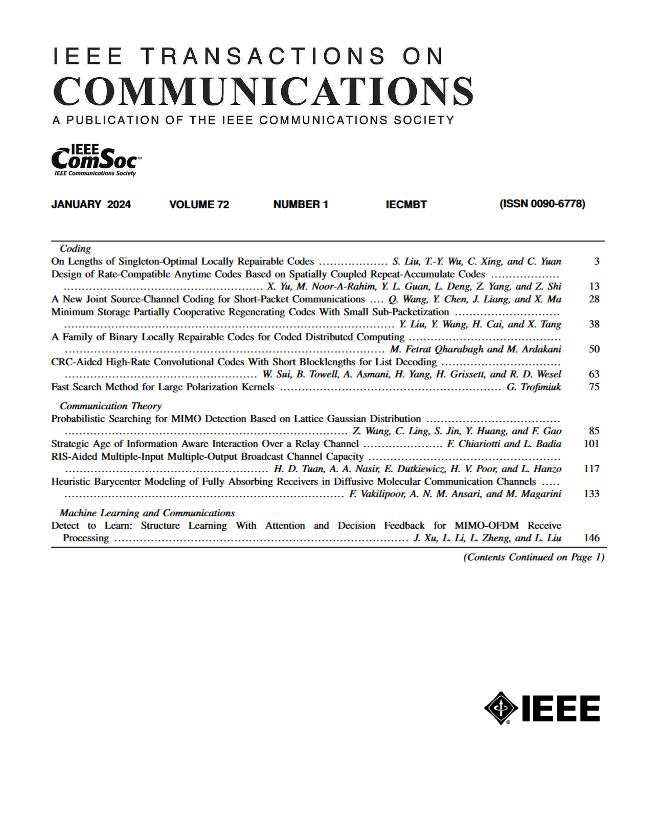利用无人机增强蜂窝网络中蜂窝边缘用户的性能
IF 8.3
2区 计算机科学
Q1 ENGINEERING, ELECTRICAL & ELECTRONIC
引用次数: 0
摘要
在蜂窝网络中,蜂窝边缘用户的性能明显不足,特别是对于那些从服务基站(BS)和干扰基站(s)接收几乎相当的信号强度的用户。为了提高无人机的性能,提出了一种蜂窝边缘无人机部署方案,将无人机部署在蜂窝边缘用户上空为其服务。具体来说,BSs的位置使用泊松点过程(PPP)建模,并形成Voronoi细胞。我们考虑位于Voronoi顶点和边界的两种不同类型的cell-edge用户,分别对应于最坏情况和边界用户。由于干扰无人机的空间分布难以处理,我们采用PPP和二项点过程(BPP)逼近来表征其干扰。随后,我们推导了这两种类型的蜂窝边缘用户的成功概率。结果表明,两种近似模型对无人机定位具有相似的有效性。在此基础上,给出了系统在高可靠状态下的渐近成功概率,并提出了基于渐近行为的有效近似,简化了系统的解析表达式。结果表明,通过提出的无人机部署方案,蜂窝边缘用户的性能得到了显著提高。本文章由计算机程序翻译,如有差异,请以英文原文为准。
Performance Enhancement for Cell-Edge Users via UAVs in Cellular Networks
In cellular networks, the performance of cell-edge users is notably deficient, especially for those receiving almost comparable signal strengths from the serving base station (BS) and interfering BS(s). To improve their performance, a cell-edge UAV deployment scheme is proposed, where the UAVs are deployed to hover over these cell-edge users to serve them. Specifically, the locations of BSs are modeled using a Poisson point process (PPP) and the Voronoi cells are formed. We consider two distinct types of cell-edge users positioned at the Voronoi vertices and boundaries, corresponding to the worst-case and boundary users, respectively. Due to the intractable spatial distribution of the interfering UAVs, we utilize the PPP and binomial point process (BPP) approximations to characterize their interference. Subsequently, we derive the success probabilities for these two types of cell-edge users. The results show the similar effectiveness of the two approximate models for the locations of the UAVs. Furthermore, we obtain the asymptotic success probabilities to analyze the performance in high-reliability regimes and propose an effective approximation based on the asymptotic behavior to simplify the analytical expressions. The results highlight the substantial performance enhancement through the proposed UAV deployment scheme for cell-edge users.
求助全文
通过发布文献求助,成功后即可免费获取论文全文。
去求助
来源期刊

IEEE Transactions on Communications
工程技术-电信学
CiteScore
16.10
自引率
8.40%
发文量
528
审稿时长
4.1 months
期刊介绍:
The IEEE Transactions on Communications is dedicated to publishing high-quality manuscripts that showcase advancements in the state-of-the-art of telecommunications. Our scope encompasses all aspects of telecommunications, including telephone, telegraphy, facsimile, and television, facilitated by electromagnetic propagation methods such as radio, wire, aerial, underground, coaxial, and submarine cables, as well as waveguides, communication satellites, and lasers. We cover telecommunications in various settings, including marine, aeronautical, space, and fixed station services, addressing topics such as repeaters, radio relaying, signal storage, regeneration, error detection and correction, multiplexing, carrier techniques, communication switching systems, data communications, and communication theory. Join us in advancing the field of telecommunications through groundbreaking research and innovation.
 求助内容:
求助内容: 应助结果提醒方式:
应助结果提醒方式:


